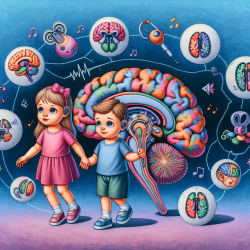Introduction
In the realm of speech-language pathology, understanding the neurological underpinnings of various disorders is crucial for effective intervention. A recent study titled Mechanisms of Ethanol-Induced Cerebellar Ataxia: Underpinnings of Neuronal Death in the Cerebellum sheds light on the impact of ethanol on cerebellar function, providing valuable insights for practitioners working with children, particularly those with Fetal Alcohol Spectrum Disorder (FASD).
The Vulnerability of the Cerebellum
The cerebellum is notably susceptible to the effects of ethanol, both in adults and during development. Chronic alcohol consumption can lead to cerebellar atrophy, particularly in the vermis, resulting in gait ataxia and postural tremor. In children, prenatal exposure to ethanol causes FASD, characterized by deficits in motor and cognitive functions, including language and social skills.
Key Mechanisms of Damage
The study highlights oxidative stress and endoplasmic reticulum (ER) stress as primary mechanisms of ethanol-induced neuronal death. These stresses are exacerbated by thiamine deficiency and neuroinflammation, particularly in fetal exposure. Ethanol also disrupts neurotransmission and neurotrophic signaling, further impairing cerebellar development.
Implications for Practitioners
For speech-language pathologists, understanding these mechanisms can inform therapeutic approaches. Here are some strategies to consider:
- Early Intervention: Early detection and intervention in children with FASD can mitigate some developmental delays. Tailoring therapy to address specific deficits in motor coordination and cognitive functions is essential.
- Multidisciplinary Approach: Collaborate with neurologists and other healthcare professionals to provide comprehensive care, addressing both neurological and behavioral aspects of FASD.
- Parent and Caregiver Education: Educate parents and caregivers about the impact of prenatal alcohol exposure and the importance of a supportive environment for cognitive and social development.
Encouraging Further Research
While this study provides significant insights, further research is needed to explore the full spectrum of ethanol's impact on the cerebellum and its implications for therapy. Practitioners are encouraged to stay informed about emerging research and incorporate new findings into their practice.
To read the original research paper, please follow this link: Mechanisms of Ethanol-Induced Cerebellar Ataxia: Underpinnings of Neuronal Death in the Cerebellum.










